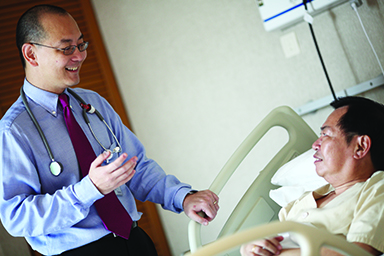NUHS Institutions will NEVER ask you to transfer money or disclose bank details over a call.
If in doubt, call the 24/7 ScamShield helpline at 1799, or visit the ScamShield website at www.scamshield.gov.sg.
Make an appointment or seek a second opinion here.
Lymphoma is a type of cancer that starts in infection-fighting white blood cells called lymphocytes which are part of the body’s immune system. There are two primary types of lymphocytes: B cells and T cells. Both are designed to recognize and destroy infections and abnormal cells. Lymphoma occurs when either lymphocyte B or T cell undergoes a malignant change and multiplies, eventually crowding out healthy cells and forming tumours. These tumours can form anywhere in the lymphatic system and affect the normal functioning of the immune system.
There are two principal kinds of lymphoma – Hodgkin and non-Hodgkin lymphoma:
The different types of lymphoma will in turn determine the symptoms and ultimately the treatment prescribed.
*People who think they may be at risk should discuss this with their doctor.
Patients who have lymphoma may not pay attention to some of the signs that are presented at the beginning as the warning signs are so subtle that it may take some time before they realise that there is anything seriously wrong. Below is a list of the common symptoms of lymphoma:
Most often these symptoms can also be caused by problems other than cancer, only a doctor can tell for sure. For an accurate diagnosis, a doctor should be consulted if the symptoms above occur.
If you experience any of the symptoms mentioned, the doctor will need to run some tests to find out what is causing the problems. Your doctor may ask about your personal and family medical history.
You may have one or more of the following tests.
Physical Examination
Your doctor checks for swollen lymph nodes in your neck, underarms and groin. He/she may also check for a swollen spleen or liver.
Blood Tests
Your doctor will do a complete blood count to check the number of white blood cells, other cells and substances such as lactate dehydrogenase (LDH). Lymphoma may cause a high level of LDH to be detected.
Chest X-Rays
Your doctor will look out for X-ray pictures indicating swollen lymph nodes or other signs of the disease in your chest.
Bone Marrow Aspiration and Biopsy
A biopsy is the removal of tissue or fluid to look for cancer cells. Your doctor may suggest to either a bone marrow aspiration (removing samples of the bone marrow fluid) or a bone marrow biopsy (removing a small piece of tissue or bone). After the samples are taken, the tissue will be checked for lymphoma cells.
Lymph Node Biopsy
Your doctor may remove an entire lymph node (excisional biopsy) or only part of a lymph node (incisional biopsy). The doctor will then check the lymph node for lymphoma cells through a microscope. Reed-Sternberg cells which are large, abnormal cells may be found in people with Hodgkin lymphoma. People with non-Hodgkin lymphoma do not have Reed-Sternberg cells.
Lumbar Puncture (Spinal Tap)
Your doctor will place a spinal needle (a long, thin needle) into the lower part of your spinal column to remove cerebrospinal fluid (CSF), a liquid around the brain and spinal cord. The fluid drawn will be sent to the lab to look for signs of cancer or if lymphoma has affected the central nervous system.
If lymphoma cells are found, the next step is to run other tests to determine what type and stage of lymphoma. Staging of lymphoma is necessary as the doctor will find out the extent of the cancer spread and this will impact the treatment options prescribed and the patient's outlook for survival.
The doctor may do one of the following imaging tests to learn how widespread lymphoma is in your body:

Lymphoma Treatment Options

Lymphoma Care Team

Lymphoma Online Resource Library

Patient Support Groups

Lymphoma Clinical Trials

Lymphoma Online Podcast Series